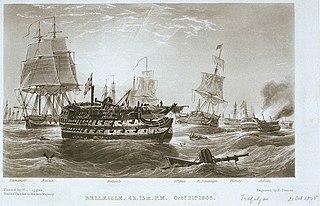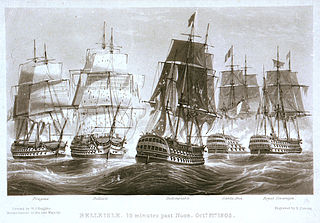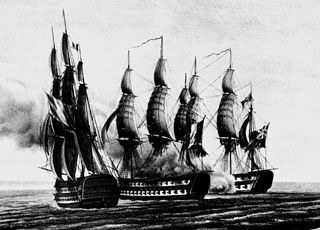
The Battle of Trafalgar was a naval engagement fought by the British Royal Navy against the combined fleets of the French and Spanish Navies during the War of the Third Coalition of the Napoleonic Wars (1803–1815).

HMS Agamemnon was a 64-gun third-rate ship of the line of the British Royal Navy. She saw service in the American Revolutionary War, French Revolutionary and Napoleonic Wars, and fought in many of the major naval battles of those conflicts. She is remembered as being Nelson's favourite ship, and was named after the mythical ancient Greek king Agamemnon, being the first ship of the Royal Navy to bear the name.

HMS Royal Sovereign was a 100-gun first-rate ship of the line of the Royal Navy, which served as the flagship of Admiral Collingwood at the Battle of Trafalgar. She was the third of seven Royal Navy ships to bear the name. Designed by Sir Edward Hunt, she was launched at Plymouth Dockyard on 11 September 1786, at a cost of £67,458, and was the only ship built of her time built to such a large draught. Due to the high number of Northumbrians on board the crew were known as the Tars of the Tyne.

HMS Neptune was a 98-gun second rate ship of the line of the Royal Navy. She served on a number of stations during the French Revolutionary and Napoleonic Wars and was present at the Battle of Trafalgar in 1805.

Vice-Admiral Sir Thomas Francis Fremantle, was a British naval officer in the Royal Navy whose accolades include three separate fleet actions, a close friendship with Lord Nelson, and a barony in Austria. He was the father of Sir Admiral Charles Fremantle, after whom the city Fremantle, in Western Australia, is named.

Lion was a Téméraire class 74-gun third rate ship of the line of the French Navy, which later served in the Royal Navy. She was named Lion on 23 April 1790 and built at Rochefort from August 1791 until June 1794. She was renamed Marat on 28 September 1793 and then Formidable on 25 May 1795, with the changing fortunes of the French Revolution.

Neptune was a Bucentaure-class 80-gun ship of the line of the French Navy. Built during the last years of the French Revolutionary Wars she was launched at the beginning of the Napoleonic Wars. Her brief career with the French included several major battles, though she spent the last 12 years of her life under the Spanish flag.

Indomptable ("Indomitable") was a Tonnant-class 80-gun ship of the line in the French Navy, laid down in 1788 and in active service from 1791. Engaged against the Royal Navy after 1794, she was damaged in the Battle of Trafalgar and wrecked near the Spanish city of Cadiz on 24 October 1805.

HMS Swiftsure was a 74-gun third rate ship of the line of the British Royal Navy. She spent most of her career serving with the British, except for a brief period when she was captured by the French during the Napoleonic Wars in the Action of 24 June 1801. She fought in several of the most famous engagements of the French Revolutionary and Napoleonic Wars, fighting for the British at the Battle of the Nile, and the French at the Battle of Trafalgar.

Rear-Admiral Sir George Johnstone Hope, KCB, KSO was a British naval officer, who served with distinction in the Royal Navy throughout the French Revolutionary and Napoleonic Wars, including service at the Battle of Trafalgar. A close personal friend of Admiral Nelson, he received many honours following the battle, and later served as a Lord of the Admiralty.

Admiral of the Blue Sir Henry Digby GCB was a senior British naval officer, who served in the French Revolutionary and Napoleonic Wars in the Royal Navy. Born into a long-established naval family, his uncle was the famous Admiral Robert Digby, Henry went to sea at the end of the American Revolutionary War aged fourteen.

Vice Admiral Sir Richard King, 2nd Baronet KCB was an officer in the Royal Navy during the French Revolutionary and Napoleonic Wars, who fought with distinction at the battle of Trafalgar despite being amongst the youngest captains present.

Admiral Sir Charles Bullen was a highly efficient and successful naval officer who served in the Royal Navy during the French Revolutionary and Napoleonic Wars and distinguished himself at the Glorious First of June, the battle of Camperdown and the battle of Trafalgar.

Sir Henry William Bayntun GCB was a senior officer in the Royal Navy, whose distinguished career in the French Revolutionary and Napoleonic Wars was a catalogue of the highest and lowest points of the Navy during the conflict. His record includes extensive operations in the West Indies followed by shipwreck, the battle of Trafalgar and the disastrous expedition to Buenos Aires in 1807.

Admiral Sir William Hargood was a British naval officer who served with distinction through the American War of Independence, the French Revolutionary War and the Napoleonic Wars, during which he gained an unfortunate reputation for bad luck, which seemed to reverse following his courageous actions at the battle of Trafalgar in command of HMS Belleisle.
Admiral Sir Thomas Bladen Capel was an officer in the British Royal Navy whose distinguished service in the French Revolutionary War, the Napoleonic Wars and the War of 1812 earned him rapid promotion and great acclaim both in and out of the Navy. He was also a great friend of Admiral Nelson and can be considered a full member of Nelson's "band of brothers".

Captain William Gordon Rutherfurd RN, CB was an officer in the Royal Navy during the French Revolutionary War and the Napoleonic Wars whose career was almost entirely conducted in the West Indies except for a brief stay in European waters during which he commanded the ship of the line HMS Swiftsure at the battle of Trafalgar.
William Prowse CB was an officer of the Royal Navy, who saw service during the American War of Independence, and the French Revolutionary and Napoleonic Wars. Rising from humble origins and joining the navy as an able seaman, he had a highly active career, serving under some of the most famous naval commanders of the age of sail, and participating in some of their greatest victories. He was at Grenada and Martinique under Byron and Rodney, the Glorious First of June under Howe; and commanded ships at Cape St Vincent under Jervis, Cape Finisterre under Calder and Trafalgar under Nelson. He finished his career by serving with distinction in the Mediterranean, and died with the rank of Rear-Admiral.
Neptuno was an 80-gun Montañes-class ship of the line of the Spanish Navy. She was built in 1795 and took part in the French Revolutionary and Napoleonic Wars. She fought with the Franco-Spanish fleet in the battle of Trafalgar, and was wrecked in its aftermath.
William Lechmere was an officer of the Royal Navy who served during the American War of Independence and the French Revolutionary and Napoleonic Wars.
















